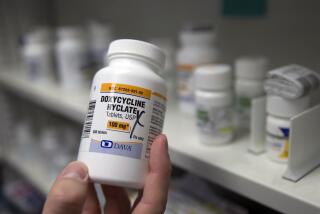Beer Tax Hikes Drive Down Gonorrhea Rate, U.S. Says
- Share via
WASHINGTON — When the price of beer goes up, teenage gonorrhea goes down, federal health officials say.
Data released Thursday by the Atlanta-based Centers for Disease Control and Prevention show that a tax increase of 20 cents per six-pack nationwide could reduce gonorrhea rates in young people by almost 9%.
Why? When teenagers drink, “they are more likely to have sex and they are more likely to have sex without a condom, with multiple partners and with high-risk partners,” said Harrell Chesson, author of the study that examined the effect of state beer taxes on rates of sexually transmitted diseases in several dozen states from 1981 to 1995.
“Drinking influences judgment,” he said.
The CDC is also looking at the effect on syphilis, and agency officials said that a preliminary analysis shows similar declines.
Untreated cases of sexually transmitted diseases can lead to reproductive-tract cancers and infertility. Unprotected sex can promote transmission of the virus that causes AIDS.
A 9% drop nationwide would translate into an annual reduction of an estimated 3,400 new cases of HIV infection, 8,900 cases of infertility and 700 cases of cervical cancer, predicted Dr. Kathleen Irwin, chief of the CDC’s health services research into preventing sexually transmitted diseases.
“This is particularly profound, given we’re talking about teenagers and young adults--the best and the brightest of our population,” she added.
In California, which increased its beer tax in July 1991 from 4 cents to 20 cents per gallon, teenage gonorrhea rates among young men dropped 30% the following year, Chesson said.
The government’s conclusions were immediately challenged by beer makers.
“Excise taxes have little or nothing to do with the level of alcohol abuse in society,” said Lori Levy, a spokeswoman for the Beer Institute.
“Our members, the brewers, spend a vast amount of resources on programs that help reduce underage drinking and drunk driving and on programs that help parents talk to their children about drinking responsibly when they are of age,” she said. “There is more success that comes from these programs than from raising the price of beer.”
CDC officials noted that there were probably other factors involved in the overall decreases but that the tax increase was a significant factor.
The CDC study analyzed changes in gonorrhea rates among teenagers 15 to 19 and young adults 20 to 24 in selected states in the year following an increase in the state beer tax or a raising of the drinking age. States that changed policy were compared with states that did not.
Among states that increased taxes on beer, two-thirds posted a decrease in gonorrhea rates for teens and three-fourths showed a decrease for young adults, CDC said.
Gonorrhea rates among teens also dropped in states that raised the drinking age, the CDC said.
The CDC said that, with few exceptions, most studies have demonstrated that alcohol consumption declines after alcohol tax increases and have shown a connection between drinking or drug use and risky sexual behavior.
“Other studies have linked alcohol consumption to other risky behaviors, including motor vehicle accidents and violent crime rates,” Irwin said.
Chesson said that gonorrhea rates among all age groups in California, including in Los Angeles, have declined sharply since beer prices went up.
In 1990, the year before the beer tax hike, the state had a total of 55,127 cases, including 20,064 in Los Angeles. In 1991, after the beer tax went up, totals declined 19% in the state and 26% in Los Angeles.
In 1998, the most recent year for which figures are available, the state total had declined to 19,518--a full 65% below where it was when the tax hike went into effect. The figure for Los Angeles had by 1998 dipped more than 70%, to 5,914. Early estimates for 1999 show the decline continuing.
“Reducing sexually transmitted diseases in youth is a very important issue,” Irwin said. “It’s a significant health threat to teens and young adults. Two-thirds of the people who get sexually transmitted diseases are under 25, and more than 3 million young people are infected annually--so it is an epidemic of concern.”
More to Read
Sign up for Essential California
The most important California stories and recommendations in your inbox every morning.
You may occasionally receive promotional content from the Los Angeles Times.












